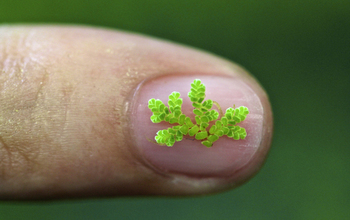Multimedia Gallery
Leaves of the fern Azolla filiculoides
The leaves of the fern Azolla filiculoides may be compared to the size of a gnat.
More about this image
Researchers at the Boyce Thompson Institute (BTI) and colleagues around the world sequenced the full genome of a tiny fern -- with each leaf the size of a gnat, possibly providing global impact for sinking atmospheric carbon dioxide, fixing nitrogen in agriculture and shooing pesky insects from crops. The tiny fern (Azolla filiculoides) is a water fern often found fertilizing rice paddies in Asia, but its ancestry goes much further back.
"Fifty million years ago, Earth was a much warmer place. Azolla, this fast-growing bloom that once covered the Arctic Circle, pulled in 10 trillion tons of carbon dioxide from our planet’s atmosphere, and scientists think it played a key role in transitioning Earth from a hot house to the cool place it is today," said Fay-Wei Li, a plant evolutionary biologist at BTI and the lead author of the published study.
Li and senior author Kathleen M. Pryer of Duke University led a group of more than 40 scientists from around the world to sequence the genome completely. As the group sequenced the genome, it identified a fern-specific gene shown to provide insect resistance.
"In general, insects don’t like ferns, and scientists wondered why," said Li, who explained that one of the fern’s genes likely transferred from a bacterium. "It’s a naturally modified gene, and now that we’ve found it, it could have huge implications for agriculture."
Nitrogen fixation is the process by which plants use the chemical element as a fertilizer. While plants cannot fix nitrogen by themselves, Li said, the genome reveals a symbiotic relationship with cyanobacteria, a blue-green phylum of bacteria that obtain their energy through photosynthesis and produce oxygen. Special cavities in the Azolla leaf host cyanobacteria to fix nitrogen, while the plant provides sugary fuel for the cyanobacteria.
"With this first genomic data from ferns, science can gain vital intelligence for understanding plant genes," said Li. "We can now research its properties as a sustainable fertilizer and perhaps gather carbon dioxide from the atmosphere."
The research was funded in part by the National Science Foundation (NSF) (grant DEB-14-07158). Learn more in the NSF News From the Field story Tiny fern holds big environmental promise. (Date image taken: 2014; date originally posted to NSF Multimedia Gallery: Dec. 17, 2018)
Credit: Fay-Wei Li
Images and other media in the National Science Foundation Multimedia Gallery are available for use in print and electronic material by NSF employees, members of the media, university staff, teachers and the general public. All media in the gallery are intended for personal, educational and nonprofit/non-commercial use only.
Images credited to the National Science Foundation, a federal agency, are in the public domain. The images were created by employees of the United States Government as part of their official duties or prepared by contractors as "works for hire" for NSF. You may freely use NSF-credited images and, at your discretion, credit NSF with a "Courtesy: National Science Foundation" notation.
Additional information about general usage can be found in Conditions.
Also Available:
Download the high-resolution JPG version of the image. (7.5 MB)
Use your mouse to right-click (Mac users may need to Ctrl-click) the link above and choose the option that will save the file or target to your computer.

